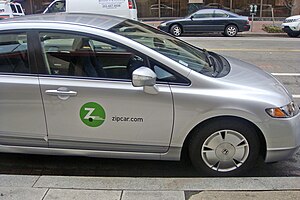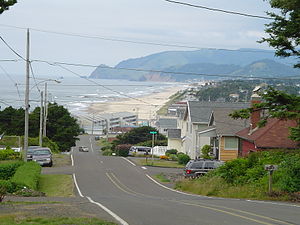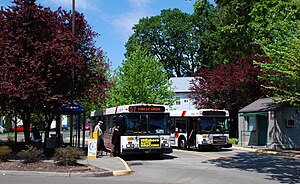 |
| English: Zip car carsharing service at downtown Washington, D.C. (Photo credit: Wikipedia) |
 |
| New Flyer C40LFR laying over ath the Federal Way Transit Center. It left a few minutes later on route 402. (Photo credit: Wikipedia) |
 |
| Lincoln City, Oregon (Photo credit: Wikipedia) |
 |
| English: Two buses at the Forest Grove, Oregon terminal of TriMet, the public transit agency serving the Portland, Oregon metropolitan area. This off-street bus loop for route 57 is located at 19th Avenue and B Street in Forest Grove and is the farthest-west point in the TriMet system. Buses 2559 and 2554 are both New Flyer D40LF units built in early 2001. The small building on the right is for use by bus drivers. (Photo credit: Wikipedia) |
One of the biggest challenges for those looking to do without a car is when trips need to be made beyond the normal transit area. For those that are able to drive there is the option of renting a car either through one of the car sharing companies such as Zipcar or traditional rental car companies.
However, renting a car is expensive and will most likely become even more expensive with Hertz taking over Dollar/Thrifty leaving only four major companies left to provide rental cars.
For those that cannot drive, the options are even worse as service to many areas is either non existent or very poor and not designed for inter-regional trips. For example, in the last few months I have made three trips to Tillamook from Portland. While there is limited bus service from Tillamook to Portland you cannot travel from Portland to spend the day in Tillamook. In fact even for people traveling to Portland the schedule only allows for five hours in Portland itself.
For another example let's look at Lincoln City, Oregon which is a major tourist destination. If you want to head to Lincoln City from Portland for the day forget it. There is only two transportation options. One is a casino bus that runs only a few days a week that will take you to Chinook Winds Casino on the north side of town. However, if your leaving from the Portland area it leaves the Gateway Transit Center at 5:30am. Not a very appealing time.
The only other option is the expensive Airport Caravan that travels from Yachats to the Portland Airport via Lincoln City and cost $55.00. Problem is it travels to Portland in the morning then returns in the early afternoon. Lincoln City used to have Greyhound service until a few years ago that was a little more affordable but still did not have the best times.
In Northwest Oregon/Southwest Washington we have a number of transit agencies including TriMet, Cherroits in Salem, SAM, SMART, Canby Area Transit, Woodburn Transit, C-Train, Lower Columbia, CUBS in Longview, Amtrak, Greyhound, Bolt, Sunset Transit, Tillamook County Transit, Lincoln County Transit, Pacific County Transit and several others I am probably forgetting about.
The problem is these agencies number one priority is their own service area and are often blind to travel needs beyond their districts. If we are going to create a sustainable alternatives to automobile travel, all agencies are going to need to work together to provide service that connects important points not just in their own area but regionally also.
To complicate matters even further is the fact that support for any transit service disappears once you leave the urban areas and that is why some districts such as Pierce Transit in Tacoma, WA cut back their service district recently and Intercity Transit in Olympia, WA did it several years ago. Officials made the decision that it was better to create a smaller district that would have more support but of course cuts those off who are located outside the new district.
One way to solve some of the problems would create a regional transit coordinating agency that would work with all the different agencies not only the transit providers themselves but other stakeholders to design a system that will create a more usable system. Recently Reconnecting America recently had a program that discussed issues in rural areas and how to more effectively service them. One agency in southern Maine worked with public and private companies to better coordinate transit service in the area including connecting it up with Amtrak's Downeaster service between Portland, Maine and Boston.
The difficulty in creating a regional agency is to create an organization that can walk the thin line between being able to work with all the agencies involved to coordinate activities including fares, service, and marketing while not alienating groups and not becoming another bureaucratic nightmare of an agency that exists on its own inertia.
Basically we are down to the old chicken and egg scenario. Do we worry about only providing transit service to the busiest urban areas and let the outer and rural areas deal with it until the time comes when transit service becomes more vital across the board or do we start to look at a big picture?
While I used the a section of the northwest for example, you could look to almost any area of the country and see the problems that exist we access to transit services and the lack of coordination between agencies. If transit service is to become a more important part of the transportation mix, service will need to be better coordinated to make transit service more useful to the largest number of possible riders.








2 comments:
thank fo posting for any help click here
Designing Buildings
hermes handbags
air force 1
converse shoes
nike vapormax
yeezy boost 350 v2
yeezy boost
adidas tubular
christian louboutin shoes
air max 2018
vapormax
Post a Comment